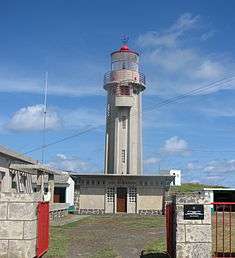Lighthouse of Carapacho
The Lighthouse of Carapacho (Portuguese: Farol do Carapacho/Ponta da Restinga) is a beacon/lighthouse located along the cliffs of Ponta da Restinga, near the hamlet of Carapacho, civil parish of Luz on the island of Graciosa, the Portuguese archipelago of the Azores.
 The Nationalist-style tower of Carapacho and utility building, alongside the lighthouse-keepers' house | |
 Portugal Azores | |

| |
| Location | Santa Cruz da Graciosa Graciosa Island Azores Portugal |
|---|---|
| Coordinates | 39°00′51.4″N 27°57′18.5″W |
| Year first constructed | 1956 |
| Automated | 1978 |
| Construction | concrete tower[1] |
| Tower shape | cylindrical tower with eight ribs rising from a one-storey keeper's house with balcony and lantern |
| Markings / pattern | unpainted tower, red lantern dome and trim |
| Tower height | 14 metres (46 ft) |
| Focal height | 191 metres (627 ft) |
| Original lens | Fourth-order light with three clarions |
| Current lens | crystal optic with a six-order light with three clarion, rotational beacon |
| Light source | mains power |
| Intensity | 50 Watt/12 Volt halogen light |
| Range | 20 nautical miles (37 km) |
| Characteristic | Fl (2) W 10s. |
| Admiralty number | D2670[2] |
| NGA number | 23484[3] |
| ARLHS number | AZO-006[4] |
| Portugal number | PT-792[5] |
| Heritage | heritage without legal protection |
History
.jpg)
.jpg)
The 1883 Plano Geral de Alumiamento (Illumiation General Plan), proposed the construction of a fourth-order lighthouse, that would flash each minute and have a 19 nautical miles (35 km) range.
On 11 November 1902, the Comissão dos Faróis e Balizas (Commission on Lighthouses and Beacons) proposed alterations to the General Plan approved in 1883, in which the lighthouse became a fifth-order structure, using a three-flash 10 second variable range beacon, with a range of use between 10–94 nautical miles (19–174 km) for clear, medium and tempetuous weather.
The lighthouse began function on 26 May 1956, equipped with a diotropic fifth-order optics, with a focal distance of 187.5 millimetres (7.38 in), moved by a clockwork mechanism. This first beacon used an incandescent red acetyline light, in two groups with a 19 nautical miles (35 km) range.
By 1961, the light became a white beacon, improving its range to 20 nautical miles (37 km)
A solar valve system was installed in 1978, that allowed the light to become active or disactived based on the atmospheric conditions.
It was only in 1987 when the lighthouse joined the electrical network on the island. At the same time the optics were substituted by a sixth-order lamp with a focal distance of 150 millimetres (5.9 in) and the lamp was upgraded to a 50 Watt/12 Volt halogen light, supported by battery and secured by exterior network.
Architecture
It is situated on the southeastern tip of the island of Graciosa, on a promontory a 1 kilometre (0.62 mi) from the village of Carapacho.
It is comparable to similar structures on the island of São Miguel, specifically the lighthouses at Ponta Garça and Ponta do Cintrão. The lighthouse consists of a round concrete tower, constructed with ribs, rising from a one-story building.
Accessible by road, the site is open to the public with access to the interior on Wednesday afternoons.
References
Notes
- Rowlett, Russ. "Lighthouses of Portugal: Azores". The Lighthouse Directory. University of North Carolina at Chapel Hill. Retrieved 10 October 2015.
- "Notice to Mariners", Admiralty List of Lights (ALL), Taunton, Sommerset, England: United Kingdom Hydrographic Office, 2011, retrieved 18 July 2011
- "Maritime Safety Information", NGA List of Lights, Springfield, Virginia: U.S. National Geospatial-Intelligence Agency (NGA), 2011, retrieved 18 July 2011
- "Identification Codes", ARLHS World List of Lights (WLOL), Merchantville, New Jersey: Amateur Radio Lighthouse Society/The Weidner Publishing Group., 2003, retrieved 18 July 2011
- Carapacho The Lighthouse Directory. University of North Carolina at Chapel Hill. Retrieved March 18, 2016
Sources
| Wikimedia Commons has media related to Ponta do Carapacho Lighthouse. |
- Eduardo Carvalho Vieira, Furtado (2005), Guardiães do Mar dos Açores: uma viagem pelas ilhas do Atlântico [Guardians of The Azores’ Seas: One Direction On These Atlantic Islands] (in Portuguese), p. 289, ISBN 972-9060-47-9
- Aguilar, J. Teixeira de; Nascimento, José Carlos (1998), Onde a Terra Acaba, História dos Faróis Portugueses (in Portuguese), Lisbon, Portugal